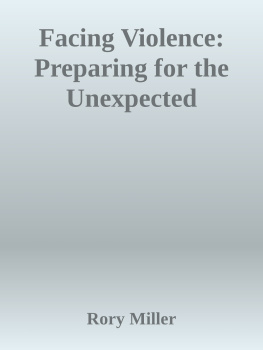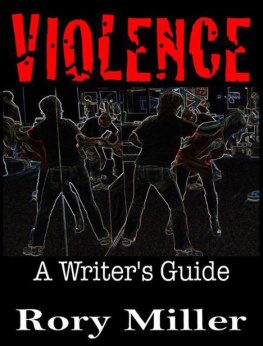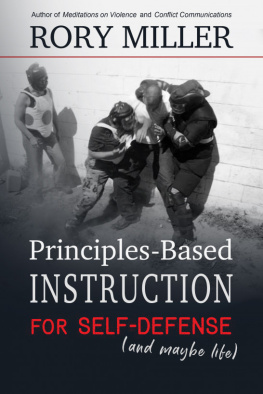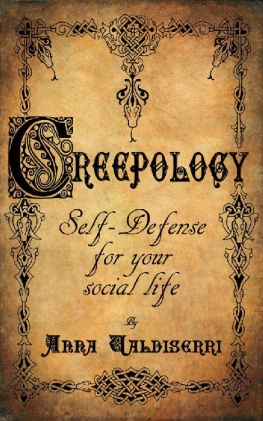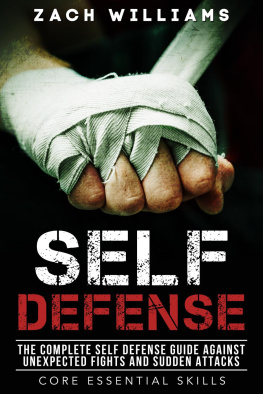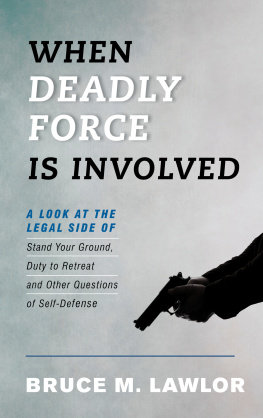Facing Violence
Ethically Emotionally Physically
(... and without going to prison.)
Rory Miller
YMAA Publication Center
Wolfeboro, N.H., USA
YMAA Publication Center, Inc.
PO Box 480
Wolfeboro, NH 03894
1-800-669-8892 www.ymaa.com info@ymaa.com
Paperback edition
978-1-59439-213-9
1-59439-213-7
Epub ebook edition
978-1-59439-237-5
1-59439-237-4
All rights reserved including the right of reproduction in whole or in part in any form.
Copyright 2011 by Rory Miller
Cover design by Axie Breen
Edited by Karen Barr Grossman
Publishers Cataloging in Publication

The authors and publisher of this material are NOT RESPONSIBLE in any manner whatsoever for any injury which may occur through reading or following the instructions in this manual.
The activities, physical or otherwise, described in this material may be too strenuous or dangerous for some people, and the readers should consult a physician before engaging in them.
acknowledgements
Like any book, any exploration of part of the human condition, Facing Violence didnt just pop out of my head complete. There have been many teachers on the way and lots of help with the process.
Some of my best teachers have been criminals. The world isnt fair, nor is it balanced in a way that humans understand. The crimes were sometimes horrible, the lessons sometimes invaluable.
Marc MacYoung has become one of my favorite Subject Matter Experts (SMEs). Long phone calls or sitting on the deck, bouncing ideas off the furry little guy is a privilege. He makes me think and often shows me things that I missed. Thanks, Marc.
Paul McRedmond (Mac) has been instrumental in teaching me to see. When I was looking at principles, he was always looking one step deeper. Hes always demanded one notch more commitment, one step more depth.
Geoff senior gave good advice when I needed it.
Steve and C.S. Cole, Mark Jones, and K encouraged me to set an impossible deadline for getting this book written. With good friends, impossible isnt that hard.
Alain Burrese kindly offered to vet the legal sections to make sure I wasnt blowing smoke out my ass.
Sifu Kevin Jackson, Rick Prowett, Kamila Miller, and Orion Storm kindly posed with this balding old man for the pictures under the direction of my lovely and talented Kami.
Karen Barr Grossman and David Ripianzi are hereby thanked for the thankless task of herding this from manuscript into something like a book.
Last and most important: This book is for Kami, who has the awesome responsibility of always keeping me sane. Ti mam rada .
foreword
There are a lot of books out there on deadly martial arts techniques and killer secrets of the ninja and the ancient principles of various lost fighting arts (I should knowI own most of them). But there arent nearly enough books on the reality of violence: the precursors, the aftermath, and everything that happens in between. Facing Violence is about the reality.
Ive been playing around with martial arts since I was a teenager: wrestling in high school, a black belt in judo from the Kodokan, a smattering of karate, boxing, and Brazilian Jiu-Jitsu. And I had some excellent training when I was with the CIA, too. All these systems turned out to be usefulsometimes extremely usefulwhen it came to the main event. But none of them prepared me for the often ambiguous lead-in to violence (like woofing), or the disorienting affects of adrenaline (like auditory exclusion and tunnel vision), or the shakes and legal complications that come after. Some of these I learned the hard way; others I feel lucky to have learned from reality-based writers like Alain Burrese, Lawrence Kane, Marc MacYoung, Peyton Quinn, and othersand now, from Rory Miller.
If youre in search of a treatise on technique, this probably isnt your book. If you want to study an ancient Asian fighting art, youll probably want to look elsewhere. But if you want to protect yourself from violence by understanding it betterrecognizing causes and signs, knowing how to de-escalate, having a plan for what to do if de-escalation fails, being prepared for the legal and other consequences that can come afterthen Facing Violence is the book for you. Its smart, its thoughtful, and its even funny and philosophical. Above all, its useful. And a damn good bargain, too, considering what Rory paid in acquiring the experience to write it.
Barry Eisler
Author of the bestselling John Rain book series
introduction
While teaching a Kurdish lieutenant in Iraq close-combat handgun skills, he suddenly threw up his hands and said something. He sounded angry. I turned to my translator and raised an eyebrow.
My translator reported, He said, I am so angry. Everything they taught us was wrong.
It wasnt true. He had been well trained on an American modelthe same skills that a rookie officer in the states would have coming out of the academy. The skills werent wrong, but they were incomplete.
Learning to shoot safely is not the same as learning to shoot quickly. Target acquisition on clear firing lanes in good lighting standing upright in a stable stance is very different from target acquisition when holding your head up for a second could mean you eat a bullet. The Lieutenant needed all of the basic skills he had learned. He was just now ready to step out of kindergarten and learn how those skills applied in the world.
Most self-defense training, and especially martial arts adapted for self-defense, suffers from the same problem. Most of what is taught is not wrong , but it is incomplete.
There are seven elements that must be addressed to bring self-defense training to something approaching complete. Any training that dismisses any of these areas leaves the student vulnerable:
Legal and ethical implications. These are different but related factors. A student learning self-defense must learn force law. Otherwise it is possible to train to go to prison . A self-defense response where you wind up behind bars for years is not a very good win. Side by side with the legal rules, every student must explore his or her own ethical limitations. Some people simply cannot bring themselves to kill, maim or blind. A few cannot hurt another human being. Most do not really know where this ethical line is within themselves. Part of an instructors duty will be to find that line and either train with respect to it or help the student grow past it.
Violence dynamics. Self-defense must teach how attacks happen. Knife defense is worthless unless it centers on how knives are actually used by predators. Students must be able to recognize an attack before it happens and know what kind they are facing. The attitudes and words that might defuse a Monkey Dance will encourage a predator assault and
vice versa.
Avoidance. Students need to learn and practice not fighting: Escape and Evasion, verbal de-escalation and also, pure not-be-there avoidance.
Counter-ambush. If the student doesnt see the precursors or cant successfully avoid the encounter, he or she will need
a handful of actions trained to reflex level for the sudden violent attack.
Breaking the freeze. Freezing is almost universal in a sudden attack. Students must learn to recognize a freeze and break out of one.
The fight itself. Most martial arts and self-defense instructors concentrate their time right here. What is taught just needs to be in line with how violence happens in the world.
The aftermath. There are potential legal, psychological, and medical effects of engaging in violence no matter how justified. Advanced preparation is critical.

